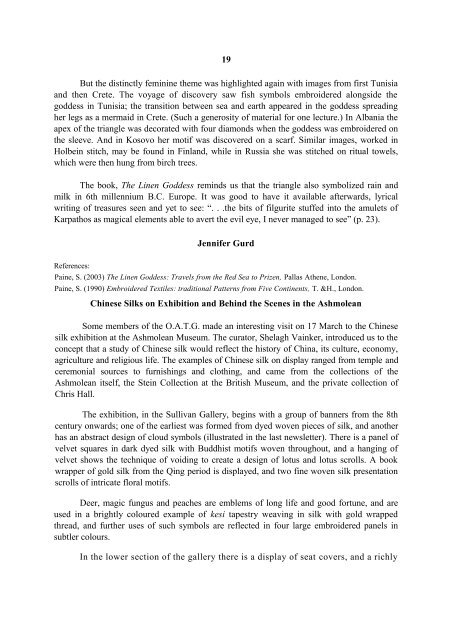download - OATG. Oxford Asian Textile Group
download - OATG. Oxford Asian Textile Group
download - OATG. Oxford Asian Textile Group
Create successful ePaper yourself
Turn your PDF publications into a flip-book with our unique Google optimized e-Paper software.
19<br />
But the distinctly feminine theme was highlighted again with images from first Tunisia<br />
and then Crete. The voyage of discovery saw fish symbols embroidered alongside the<br />
goddess in Tunisia; the transition between sea and earth appeared in the goddess spreading<br />
her legs as a mermaid in Crete. (Such a generosity of material for one lecture.) In Albania the<br />
apex of the triangle was decorated with four diamonds when the goddess was embroidered on<br />
the sleeve. And in Kosovo her motif was discovered on a scarf. Similar images, worked in<br />
Holbein stitch, may be found in Finland, while in Russia she was stitched on ritual towels,<br />
which were then hung from birch trees.<br />
The book, The Linen Goddess reminds us that the triangle also symbolized rain and<br />
milk in 6th millennium B.C. Europe. It was good to have it available afterwards, lyrical<br />
writing of treasures seen and yet to see: “. . .the bits of filgurite stuffed into the amulets of<br />
Karpathos as magical elements able to avert the evil eye, I never managed to see” (p. 23).<br />
Jennifer Gurd<br />
References:<br />
Paine, S. (2003) The Linen Goddess: Travels from the Red Sea to Prizen, Pallas Athene, London.<br />
Paine, S. (1990) Embroidered <strong>Textile</strong>s: traditional Patterns from Five Continents, T. &H., London.<br />
Chinese Silks on Exhibition and Behind the Scenes in the Ashmolean<br />
Some members of the O.A.T.G. made an interesting visit on 17 March to the Chinese<br />
silk exhibition at the Ashmolean Museum. The curator, Shelagh Vainker, introduced us to the<br />
concept that a study of Chinese silk would reflect the history of China, its culture, economy,<br />
agriculture and religious life. The examples of Chinese silk on display ranged from temple and<br />
ceremonial sources to furnishings and clothing, and came from the collections of the<br />
Ashmolean itself, the Stein Collection at the British Museum, and the private collection of<br />
Chris Hall.<br />
The exhibition, in the Sullivan Gallery, begins with a group of banners from the 8th<br />
century onwards; one of the earliest was formed from dyed woven pieces of silk, and another<br />
has an abstract design of cloud symbols (illustrated in the last newsletter). There is a panel of<br />
velvet squares in dark dyed silk with Buddhist motifs woven throughout, and a hanging of<br />
velvet shows the technique of voiding to create a design of lotus and lotus scrolls. A book<br />
wrapper of gold silk from the Qing period is displayed, and two fine woven silk presentation<br />
scrolls of intricate floral motifs.<br />
Deer, magic fungus and peaches are emblems of long life and good fortune, and are<br />
used in a brightly coloured example of kesi tapestry weaving in silk with gold wrapped<br />
thread, and further uses of such symbols are reflected in four large embroidered panels in<br />
subtler colours.<br />
In the lower section of the gallery there is a display of seat covers, and a richly
















